Abstract
The effects of purified Pasteurella multocida toxin (PMT) on osteoclast formation from hemopoietic progenitor cells were studied using an in vitro system. Mononuclear adherent mouse bone marrow cells were cultured for 7 or 14 days in the presence of PMT, or 1,25-dihydroxy-vitamin D3, or both. Mononuclear osteoclast-like cells, which are postmitotic osteoclast precursor cells, were identified as tartrate-resistant acid phosphatase (TRAP)-positive mononuclear cells possessing calcitonin receptors. Multinucleated osteoclast-like cells were TRAP-positive multinuclear cells with calcitonin receptors. The results demonstrate that, as does 1,25(OH)2D3, Pasteurella multocida toxin stimulates proliferation of adherent bone marrow mononuclear cells (progenitor cells), and their differentiation into postmitotic mononuclear osteoclast precursor cells. It also causes fusion of the latter into multinuclear osteoclasts; however, the number of osteoclasts obtained with PMT is smaller than with 1,25-dihydroxy-vitamin D3.
Full text
PDF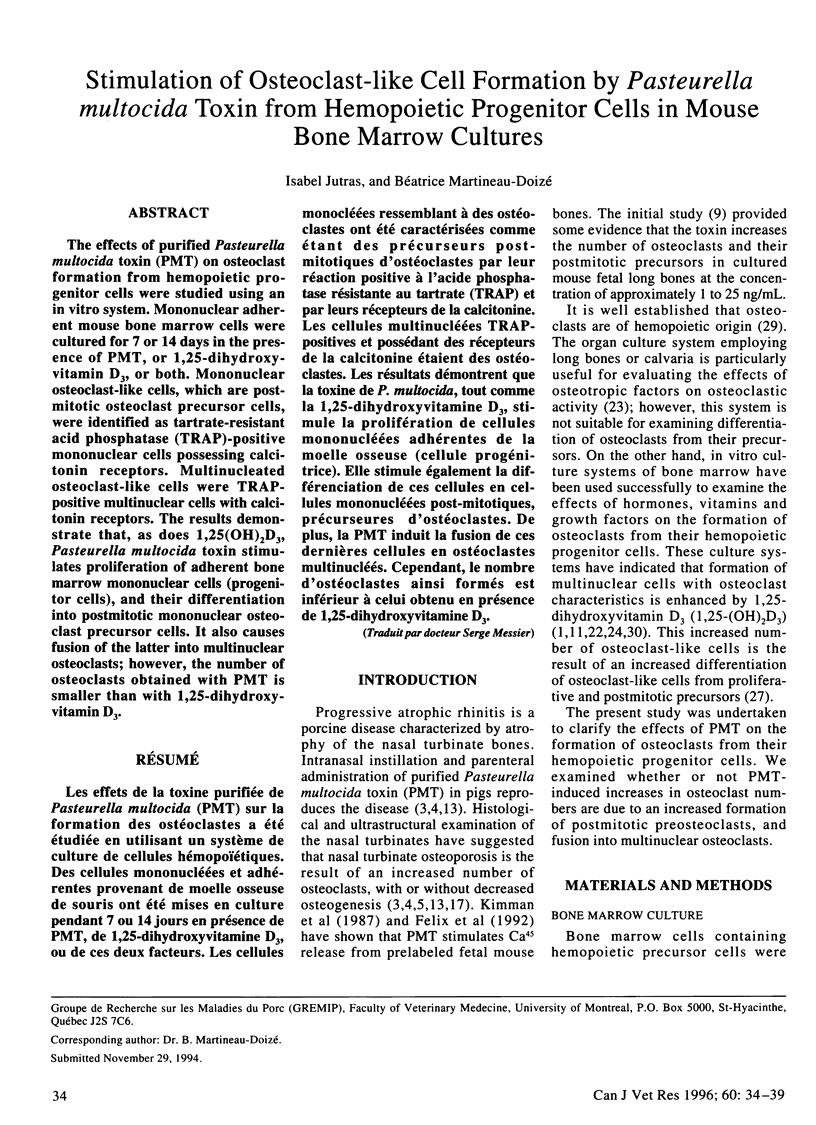
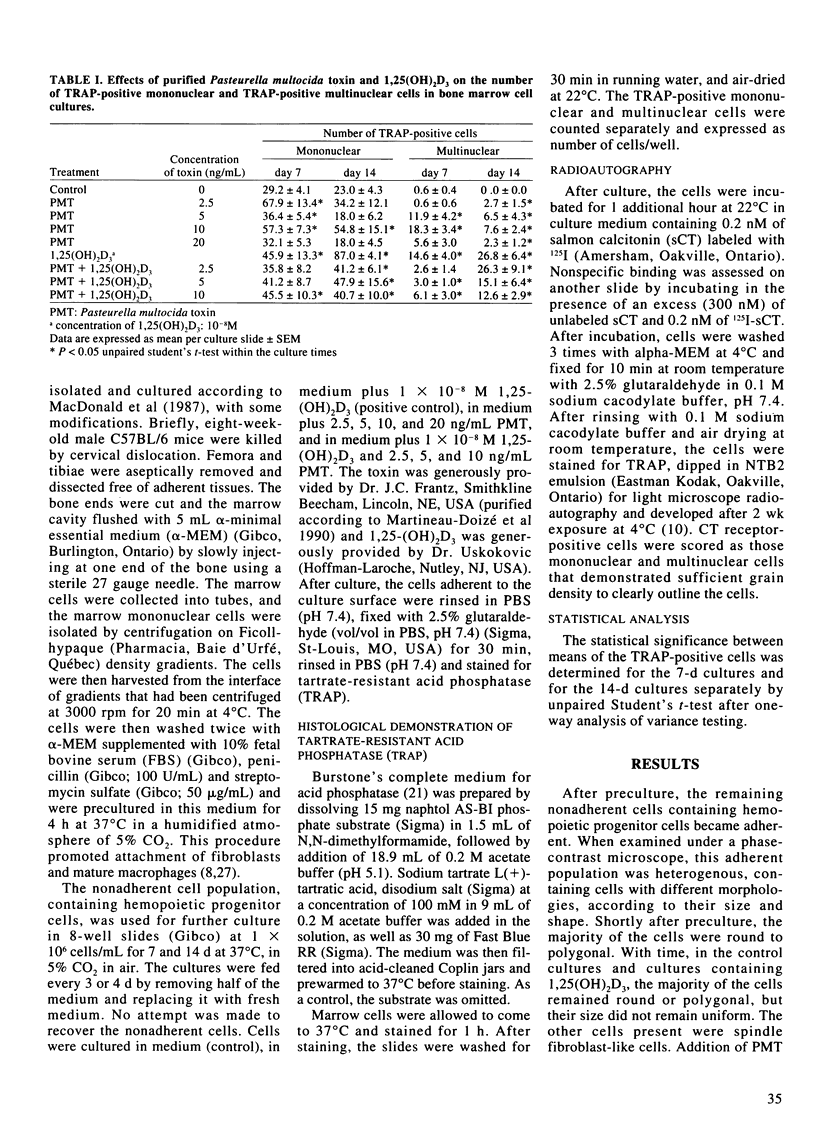
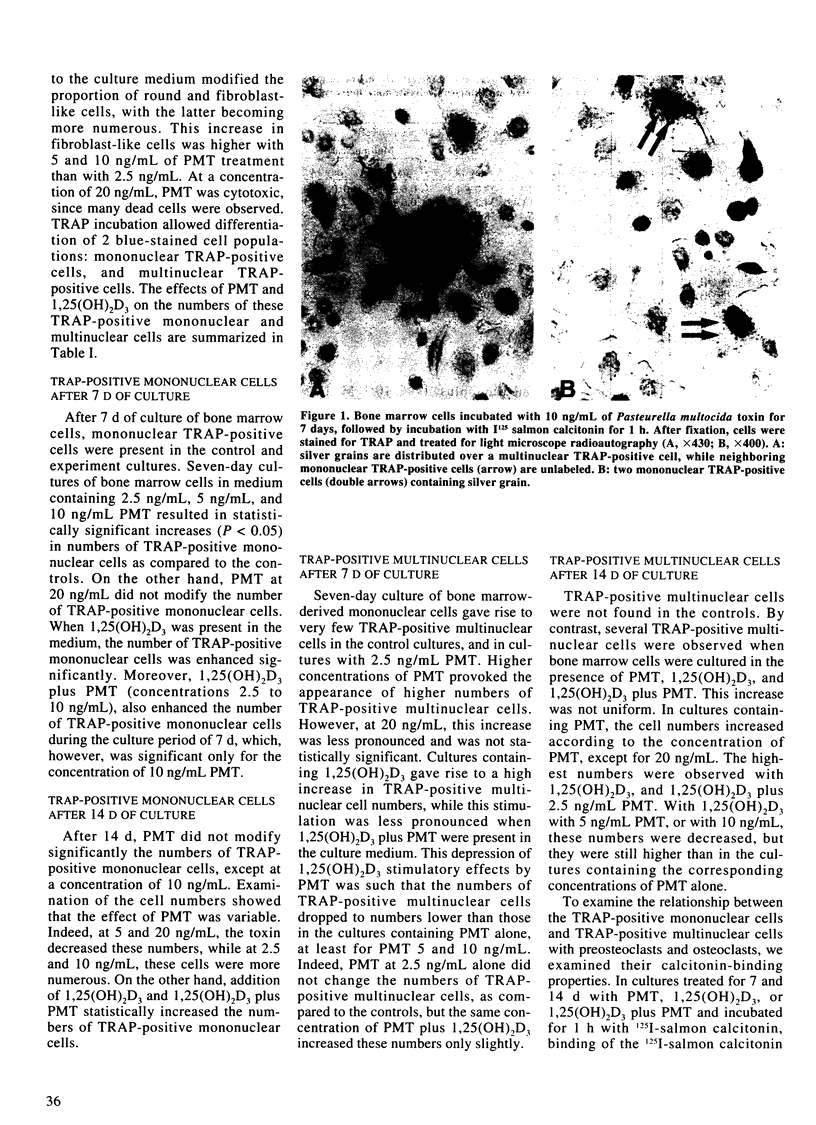
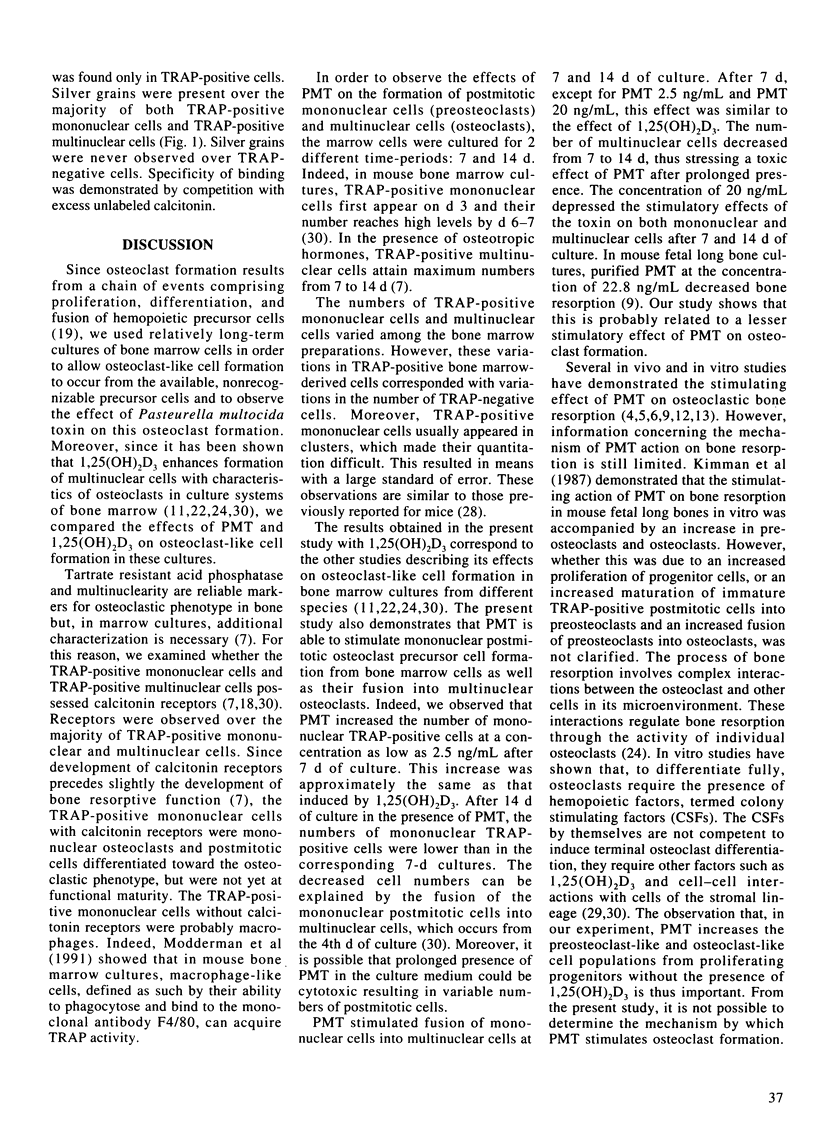
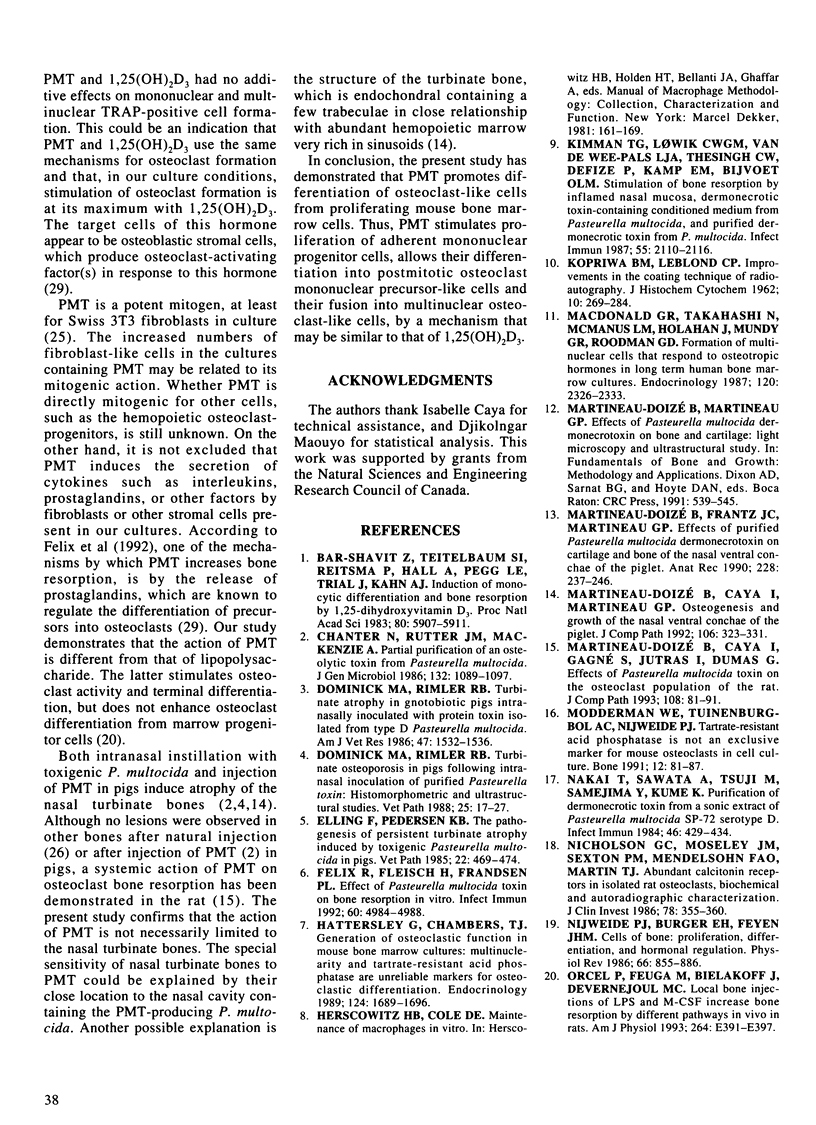
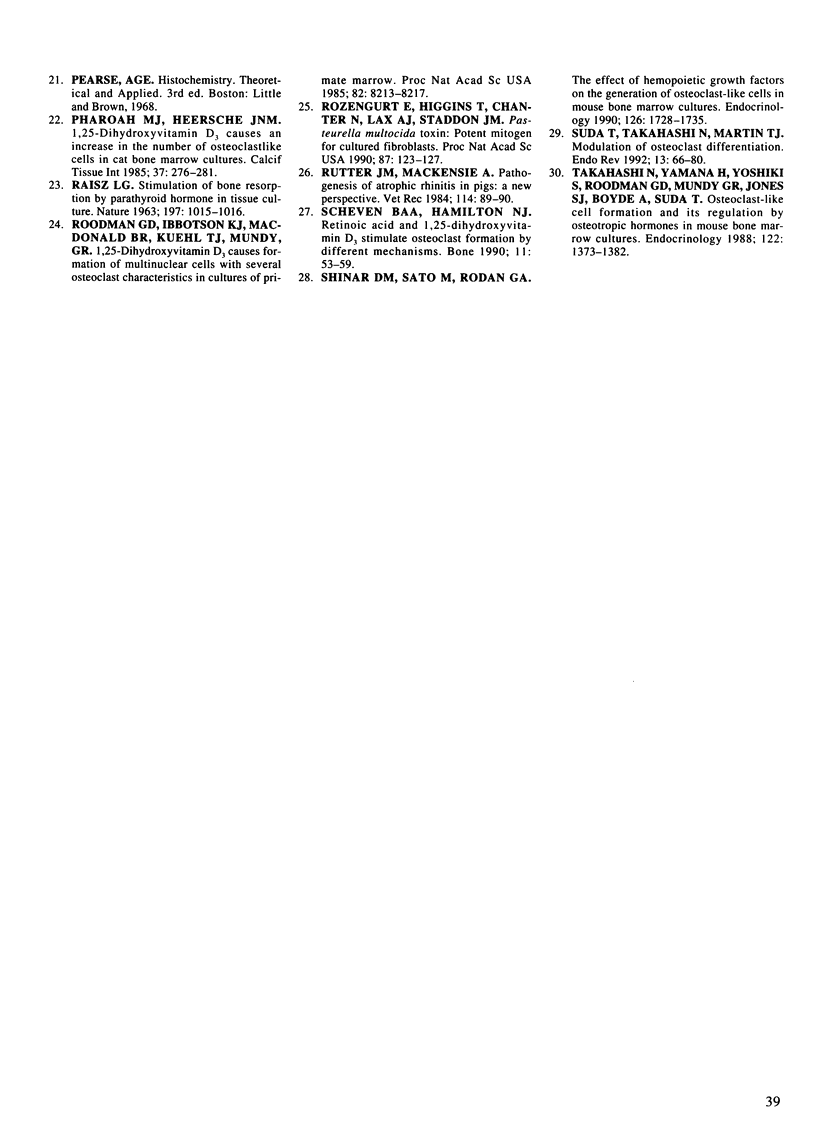
Images in this article
Selected References
These references are in PubMed. This may not be the complete list of references from this article.
- Bar-Shavit Z., Teitelbaum S. L., Reitsma P., Hall A., Pegg L. E., Trial J., Kahn A. J. Induction of monocytic differentiation and bone resorption by 1,25-dihydroxyvitamin D3. Proc Natl Acad Sci U S A. 1983 Oct;80(19):5907–5911. doi: 10.1073/pnas.80.19.5907. [DOI] [PMC free article] [PubMed] [Google Scholar]
- Chanter N., Rutter J. M., Mackenzie A. Partial purification of an osteolytic toxin from Pasteurella multocida. J Gen Microbiol. 1986 Apr;132(4):1089–1097. doi: 10.1099/00221287-132-4-1089. [DOI] [PubMed] [Google Scholar]
- Dominick M. A., Rimler R. B. Turbinate atrophy in gnotobiotic pigs intranasally inoculated with protein toxin isolated from type D Pasteurella multocida. Am J Vet Res. 1986 Jul;47(7):1532–1536. [PubMed] [Google Scholar]
- Dominick M. A., Rimler R. B. Turbinate osteoporosis in pigs following intranasal inoculation of purified Pasteurella toxin: histomorphometric and ultrastructural studies. Vet Pathol. 1988 Jan;25(1):17–27. doi: 10.1177/030098588802500103. [DOI] [PubMed] [Google Scholar]
- Elling F., Pedersen K. B. The pathogenesis of persistent turbinate atrophy induced by toxigenic Pasteurella multocida in pigs. Vet Pathol. 1985 Sep;22(5):469–474. doi: 10.1177/030098588502200506. [DOI] [PubMed] [Google Scholar]
- Felix R., Fleisch H., Frandsen P. L. Effect of Pasteurella multocida toxin on bone resorption in vitro. Infect Immun. 1992 Dec;60(12):4984–4988. doi: 10.1128/iai.60.12.4984-4988.1992. [DOI] [PMC free article] [PubMed] [Google Scholar]
- Hattersley G., Chambers T. J. Generation of osteoclastic function in mouse bone marrow cultures: multinuclearity and tartrate-resistant acid phosphatase are unreliable markers for osteoclastic differentiation. Endocrinology. 1989 Apr;124(4):1689–1696. doi: 10.1210/endo-124-4-1689. [DOI] [PubMed] [Google Scholar]
- Kimman T. G., Löwik C. W., van de Wee-Pals L. J., Thesingh C. W., Defize P., Kamp E. M., Bijvoet O. L. Stimulation of bone resorption by inflamed nasal mucosa, dermonecrotic toxin-containing conditioned medium from Pasteurella multocida, and purified dermonecrotic toxin from P. multocida. Infect Immun. 1987 Sep;55(9):2110–2116. doi: 10.1128/iai.55.9.2110-2116.1987. [DOI] [PMC free article] [PubMed] [Google Scholar]
- MacDonald B. R., Takahashi N., McManus L. M., Holahan J., Mundy G. R., Roodman G. D. Formation of multinucleated cells that respond to osteotropic hormones in long term human bone marrow cultures. Endocrinology. 1987 Jun;120(6):2326–2333. doi: 10.1210/endo-120-6-2326. [DOI] [PubMed] [Google Scholar]
- Martineau-Doizé B., Caya I., Gagné S., Jutras I., Dumas G. Effects of Pasteurella multocida toxin on the osteoclast population of the rat. J Comp Pathol. 1993 Jan;108(1):81–91. doi: 10.1016/s0021-9975(08)80230-7. [DOI] [PubMed] [Google Scholar]
- Martineau-Doizé B., Caya I., Martineau G. P. Osteogenesis and growth of the nasal ventral conchae of the piglet. J Comp Pathol. 1992 May;106(4):323–331. doi: 10.1016/0021-9975(92)90018-p. [DOI] [PubMed] [Google Scholar]
- Martineau-Doizé B., Frantz J. C., Martineau G. P. Effects of purified Pasteurella multocida dermonecrotoxin on cartilage and bone of the nasal ventral conchae of the piglet. Anat Rec. 1990 Nov;228(3):237–246. doi: 10.1002/ar.1092280302. [DOI] [PubMed] [Google Scholar]
- Modderman W. E., Tuinenburg-Bol Raap A. C., Nijweide P. J. Tartrate-resistant acid phosphatase is not an exclusive marker for mouse osteoclasts in cell culture. Bone. 1991;12(2):81–87. doi: 10.1016/8756-3282(91)90004-3. [DOI] [PubMed] [Google Scholar]
- Nakai T., Sawata A., Tsuji M., Samejima Y., Kume K. Purification of dermonecrotic toxin from a sonic extract of Pasteurella multocida SP-72 serotype D. Infect Immun. 1984 Nov;46(2):429–434. doi: 10.1128/iai.46.2.429-434.1984. [DOI] [PMC free article] [PubMed] [Google Scholar]
- Nicholson G. C., Moseley J. M., Sexton P. M., Mendelsohn F. A., Martin T. J. Abundant calcitonin receptors in isolated rat osteoclasts. Biochemical and autoradiographic characterization. J Clin Invest. 1986 Aug;78(2):355–360. doi: 10.1172/JCI112584. [DOI] [PMC free article] [PubMed] [Google Scholar]
- Nijweide P. J., Burger E. H., Feyen J. H. Cells of bone: proliferation, differentiation, and hormonal regulation. Physiol Rev. 1986 Oct;66(4):855–886. doi: 10.1152/physrev.1986.66.4.855. [DOI] [PubMed] [Google Scholar]
- Orcel P., Feuga M., Bielakoff J., De Vernejoul M. C. Local bone injections of LPS and M-CSF increase bone resorption by different pathways in vivo in rats. Am J Physiol. 1993 Mar;264(3 Pt 1):E391–E397. doi: 10.1152/ajpendo.1993.264.3.E391. [DOI] [PubMed] [Google Scholar]
- Pharoah M. J., Heersche J. N. 1,25-Dihydroxyvitamin D3 causes an increase in the number of osteoclastlike cells in cat bone marrow cultures. Calcif Tissue Int. 1985 May;37(3):276–281. doi: 10.1007/BF02554874. [DOI] [PubMed] [Google Scholar]
- RAISZ L. G. Stimulation of bone resorption by parathyroid hormone in tissue culture. Nature. 1963 Mar 9;197:1015–1016. doi: 10.1038/1971015a0. [DOI] [PubMed] [Google Scholar]
- Roodman G. D., Ibbotson K. J., MacDonald B. R., Kuehl T. J., Mundy G. R. 1,25-Dihydroxyvitamin D3 causes formation of multinucleated cells with several osteoclast characteristics in cultures of primate marrow. Proc Natl Acad Sci U S A. 1985 Dec;82(23):8213–8217. doi: 10.1073/pnas.82.23.8213. [DOI] [PMC free article] [PubMed] [Google Scholar]
- Rozengurt E., Higgins T., Chanter N., Lax A. J., Staddon J. M. Pasteurella multocida toxin: potent mitogen for cultured fibroblasts. Proc Natl Acad Sci U S A. 1990 Jan;87(1):123–127. doi: 10.1073/pnas.87.1.123. [DOI] [PMC free article] [PubMed] [Google Scholar]
- Rutter J. M., Mackenzie A. Pathogenesis of atrophic rhinitis in pigs: a new perspective. Vet Rec. 1984 Jan 28;114(4):89–90. doi: 10.1136/vr.114.4.89. [DOI] [PubMed] [Google Scholar]
- Scheven B. A., Hamilton N. J. Retinoic acid and 1,25-dihydroxyvitamin D3 stimulate osteoclast formation by different mechanisms. Bone. 1990;11(1):53–59. doi: 10.1016/8756-3282(90)90072-7. [DOI] [PubMed] [Google Scholar]
- Shinar D. M., Sato M., Rodan G. A. The effect of hemopoietic growth factors on the generation of osteoclast-like cells in mouse bone marrow cultures. Endocrinology. 1990 Mar;126(3):1728–1735. doi: 10.1210/endo-126-3-1728. [DOI] [PubMed] [Google Scholar]
- Suda T., Takahashi N., Martin T. J. Modulation of osteoclast differentiation. Endocr Rev. 1992 Feb;13(1):66–80. doi: 10.1210/edrv-13-1-66. [DOI] [PubMed] [Google Scholar]
- Takahashi N., Yamana H., Yoshiki S., Roodman G. D., Mundy G. R., Jones S. J., Boyde A., Suda T. Osteoclast-like cell formation and its regulation by osteotropic hormones in mouse bone marrow cultures. Endocrinology. 1988 Apr;122(4):1373–1382. doi: 10.1210/endo-122-4-1373. [DOI] [PubMed] [Google Scholar]



